Use 'Print preview' to check the number of pages and printer settings.
Print functionality varies between browsers.
Printable page generated Wednesday, 19 November 2025, 11:30 PM
Health Management, Ethics and Research Module: 5. Monitoring and Control
Study Session 5 Monitoring and Control
Introduction
Monitoring and controlling performance is widely accepted as one of the most important managerial functions. In this study session you will learn about the key managerial tasks related to monitoring and control. These include activities and resources that will ensure that your healthcare work is effective in achieving planned objectives and will enable you to better understand the link between planning, implementation and control of your health plans. Monitoring and control of your work will also help you to decide the actions that need to be taken when any deviation from objectives occurs.
In this study session you will explore the factors that need to be considered when setting up an effective system of monitoring and control for your own practice. You will also consider how to monitor and control the volunteers and model families in your community who contribute to the healthcare of your community.
Finally, you will learn how to generate information through observation and the collection of routine statistics and reports, in order to monitor performance against set standards.
Learning Outcomes for Study Session 5
When you have studied this session, you should be able to:
5.1 Define and use correctly all of the key words printed in bold. (SAQs 5.1, 5.2 and 5.4)
5.2 Explain the importance of monitoring and control for your healthcare practice. (SAQs 5.1 and 5.2)
5.3 Identify the main ways of gathering the information you need for monitoring and performance control of your health work in the community. (SAQ 5.3)
5.4 Describe how you would provide constructive feedback to someone whose performance you are monitoring. (SAQ 5.5)
5.1 Monitoring in healthcare management
Monitoring is about collecting information that will help you answer questions about the health-related performance of you and your team. As a Health Extension Practitioner you will be expected to check on how well your activities are progressing. It is important that you record and monitor the services you are providing in a planned, organised and routine way so that you can use this information to report on your team’s performance.
What is monitoring?
Monitoring is the regular observation and recording of activities that will help you answer questions about your team’s performance.
Each Health Extension Practitioner needs to keep records and notes, and you should also discuss with the people around you what you are doing in your work. This simple checking becomes known as ‘monitoring’ when information is collected routinely and systematically against a plan. The information might be about the services you are providing, for example the number of children vaccinated or number of bed nets distributed, or about other activities such as training volunteers and model families, or even organising health education events. You can collect monitoring information on a daily, monthly or quarterly basis. Monitoring also involves giving information to your supervisors and managers about the health services that you are providing for the community (Figure 5.1). For example reporting the number of children vaccinated in the village.
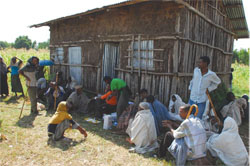
Which of these items should be monitored as part of your work as a Health Extension Practitioner?
- The number of vaccinations given to children in your kebele.
- The number of bed nets distributed.
- The number of people attending your health education activities.
- The number of model families that you have trained.
In fact all these functions are important parts of your work and should be regularly monitored.
Reporting enables gathered information to be used in making decisions to improve service performance. For example, if monitoring identifies the shortage of bed nets in the village you should report this to your supervisor.
5.1.1 The purpose of monitoring
Monitoring is very important in Primary Health Care service planning and implementation.
Box 5.1 sets out some of the ways that monitoring information can be used by you and your team of village level health workers such as model families and other volunteers. Getting information in this way will also be useful for your supervisor and other managers in the health services.
Box 5.1 The uses of monitoring information
- Understanding the health situation in your community and how the health services are performing.
- Determining whether the resources in the health services are being well used.
- Ensuring that all activities are carried out properly by the right people and at the right time.
- Ensuring that activities and tasks are performed in accordance with set standards.
- Identifying health problems facing the community and starting to find solutions.
- Ensuring community groups and local individuals participate appropriately in health activities.
Look closely at the uses of monitoring information that are set out in Box 5.1. Which of these uses will be helpful to you as a Health Extension Practitioner, and which will be of use to your supervisor and managers in the health service?
In fact all these items will be of use to you when you are trying to record and report back on the work that you do. Information on all these activities will also be useful for your supervisor and other managers in the health service.
Here are some basic points for successful monitoring:
- Build simple information collection methods.
- Understand why you collect all those pieces of information.
- Make sure that all your monitoring records are completed fully and accurately.
- Give people who are providing you with information feedback on the monitoring results and explain to them how monitoring is being used to make the service more effective.
- Check that the service is not collecting the same piece of information more than once.
Why do you think it is important to be accurate in your collection of information about the services that you are providing?
Inaccurate information may lead to the wrong action being taken in the future. If the correct data is not collected then it becomes impossible to plan proper healthcare for the people in your community.
5.1.2 Methods of gathering information for monitoring
In reporting your health-related activities, you need to collect information that will tell you how well you have done in terms of your targets, and compare this information with the things you planned to achieve.
Some of the sources of information available to you include:
- Examining records: for example health service records, financial and administrative records.
- Documentation: for example letters, reports, plans, attendance lists, forms, invoices, receipts, minutes of meetings and official reports.
- Continually observing work progress, staff performance and service achievements.
- Discussing progress and any problems with staff and with the community.
When doing your monitoring, what information is routinely collected and what information will you have to collect specially for monitoring?
The whole idea of monitoring is that you do not need to collect special information. All the information you require should be collected on a routine, systematic basis. No special information is required, just the regular statistics that should be gathered during your usual work.
Standard reporting formats, such as tally sheets (Figure 5.2), need to be designed to collect health information data from the client or patient records.
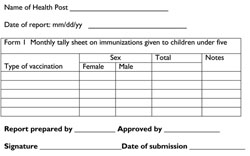
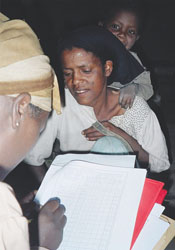
Standardisation of the reporting format is usually done by the Ministry of Health or Regional Health Bureau. However, as a Health Extension Practitioner you may need to develop some data collection forms yourself so that you can collect information about the work that you and your team are doing (Figure 5.3).
In order to obtain a comprehensive picture of the health status of people in your community, information from additional sources may be needed. You should always have a notebook to collect data as you go about your work (Figure 5.4). It may also be necessary to collect extra information from sources such as non-governmental (NGO) community-based organisations and nearby health facilities. For example, if a community-based organisation trains peer educators on social mobilisation, or provides services for orphans and vulnerable children, you should collect this information from them so that you can report to the next level about your community health services as a whole.
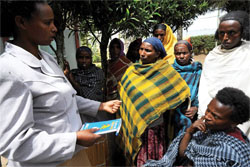
Information obtained from monitoring can be used to identify day-to-day problems, as well as for regular planning of the health work in your community. It is essential to be aware of the significance of the information you collect and to be confident of its correctness. Records must be reviewed at regular intervals and information must be verified. For example, you may be able to confirm the accuracy of your records by asking questions such as:
- Is the programme or service operating as needed?
- Are the volunteers completing the model household checklists correctly?
- Is training of model households being carried out as intended?
- Does the Health Post receive adequate vaccination kits?
What other organisations do you think might provide information that could help you with monitoring the work of the health services within your community?
Not all health service activity is provided by the Federal Ministry of Health; there may also be NGO health-related organisations at work in your area. Other government agencies and community groups may also be involved in keeping people healthy. Your monitoring activities should also include their work.
5.1.3 Using a checklist
As a Health Extension Practitioner you may need to use checklists to observe performance and recognise problems in work standards (Figure 5.5). A checklist is a set of criteria that you can prepare to assist you in monitoring your own activities. A checklist can also be a record or a reminder of what has been happening so that you can follow the progress you are making. This will help you to trace the causes of any work problems. Problems may be caused by personal, administrative, technical or organisational difficulties. For example, receiving expired drugs is a technical fault.
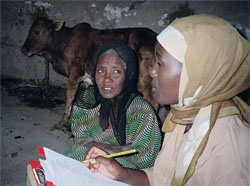
Case Study 5.1 Monitoring vaccination coverage rates
In kebele X the objective for this year is to vaccinate 85% of the children under six months of age with oral polio vaccine (OPV).
There are a total of 550 eligible children in the village, so the target figure is 85/100 x 550 = 468 children to be vaccinated in the year.
The monthly checklist for vaccination of these children is shown in Table 5.1. The first column shows the number of children who have been newly vaccinated each month. The second column is a cumulative total of the actual number of children vaccinated to date. The checklist records the monthly figures for the past six months and you can see that 263 eligible children have been vaccinated so far.
This number can be compared with the target of 85% of all 550 children, which is 468, to see whether the work is progressing as expected.
| Months | Number of children vaccinated each month | Cumulative total number of vaccinated children |
|---|---|---|
| January | 20 | 20 |
| February | 23 | 43 |
| March | 35 | 78 |
| April | 50 | 128 |
| May | 55 | 183 |
| June | 80 | 263 |
Looking at the monthly checklist in Table 5.1, is the trend of numbers of children being vaccinated increasing or decreasing?
If the current trend continues over the next six months, will you achieve your target? Explain how you would show this in your report.
Yes, the figures in the table show an increasing trend over the last six months of newly vaccinated children under six months of age. In January only 20 children were vaccinated, while four times this number (80) were vaccinated in June.
Comparing what has been achieved (263) with what has been planned (468) you can calculate that a vaccination target of 57% has been achieved in the first six months (263/468 x 100 = 57%). This shows that if the current trend continues, you are likely to achieve the target of 85% by the end of the year.
5.1.4 Supervision

Monitoring information can also be gathered through supervision. Supervision is usually a meeting at which you are able to sit down with a senior colleague and discuss issues that are important in your work (Figure 5.6). It is one way to make sure that your objectives correspond to the health needs of your community. It might also be that as a Health Extension Practitioner you find yourself doing supervision of other members of your team. During that sort of supervision you can discuss, explain, justify, and obtain the commitment of community workers to the objectives of the programme. Supervision makes sure that there are no divergences between the objectives and the team’s standard of performance. It seeks solutions to any conflict that may have arisen between the health practitioners and community workers or members of your community regarding the programme objectives.
Supervision is one way to discover how tasks entrusted to different categories of worker are carried out, and under what conditions. You should be able to analyse the factors that result in satisfactory performance and uncover any obstacles to meeting your objectives. It helps you to determine the causes of difficulties.
What is the similarity between running a supervision session for a member of your team and being supervised yourself by a more senior colleague?
In both instances it should be possible to have an open discussion about work plans and how you and your team are working towards improving the health of your community.
5.2 Steps of managerial control
Control is a basic managerial function involving setting standards, evaluating against standards and taking corrective action. It is the process of regulating service activities so that your performance conforms to expected standards and goals, and it ensures that the necessary corrective action is taken whenever deviations occur.
In managerial terms, control ensures that your health work is accomplished according to agreed action plans. It is a process of ensuring that the work that you do produces the desired results. Control is a continuous activity. As a Health Extension Practitioner you will need to control your local primary healthcare services and the resources you have in order to minimise mistakes, inefficiency and wastage.
If there are things going wrong with your services, monitoring will point the way to timely corrective action which should lead to an improvement in the performance of your health team.
How can monitoring information accurately help maintain effective control?
From the previous section, you know that monitoring performance on a regular basis helps you to know where you are in term of work progress, staff performance and service achievements.
As a Health Extension Practitioner you will be involved in the four steps of controlling. First of all, you should establish the necessary standards required to ensure that achievements are in accordance with your overall plan. In the second step, you measure performance. In the third step you compare that performance with the predetermined standards. If there is any deviation you will be able to take corrective action, which is the final step in the controlling function.
5.2.1 Establishing standards of performance
The first step in the control process is the establishment of standards for the measurement of performance. Standards must be established and expressed in such a way that the people concerned can easily understand them and the outcomes can be measured without difficulty.
Your standard might be to increase the number of pregnant women attending antenatal care by 20% in the village this year.
Do you think this a suitable standard?
Yes, standards of performance should be simple and capable of achievement with a reasonable commitment of cost, effort and time.
5.2.2 Measuring performance
The second step in the control process is the accurate measurement of performance (Figure 5.7). You should measure your actual performance and compare it with the standards you have set. Quantitative measurements should be done in cases where standards have been set in numerical terms; for example 500 pregnant women should attend your antenatal care service this year. This will make measuring performance quite easy and simple. In other cases, the performance can be measured in terms of qualitative factors, for example, how well the model household training went.

Which of these performance measurements is quantitative?
- a.16 couples had HIV testing before marriage.
- b.326 ITNs (insecticide treated bed nets) were distributed in the kebele.
- c.All the women who came for antenatal care gave positive feedback.
a. and b. are quantitative measurements because they have numbers attached to them. c. is qualitative because it tells us about the quality of the service that has been provided.
5.2.3 Comparing performance with standards
The third step in the control process is the comparison of performance with established standards. You can base your comparison on the monitoring information you collected for services that you have provided or activities you have organised. Then you summarise the outcomes as planned versus actual results. See Table 5.2 for an example.
| Activities | Planned (target) | Performed (actual) | Percentage achieved |
|---|---|---|---|
| Antenatal visits during the year | 500 | 250 | 50% |
| Train model households during the year | 180 | 120 | 66% |
| Number of community events conducted | 3 | 2 | 66% |
5.2.4 Taking corrective action
The fourth and final step in the control process is taking corrective action. When problems are identified, corrective action is obviously called for. This involves those in management roles taking appropriate decisions, such as the replanning or redrawing of goals or standards and perhaps changing the way that things are done. This may also require further training of the healthworkers in your team.
Look closely at Table 5.2. How do you think these figures could help you to plan your future activities?
None of the targets have been met during the year. But the number of antenatal visits is the target that has been missed by the greatest amount. This will require the most effort during the coming year.
5.3 Constructive and effective feedback
We all need feedback to help us improve. As a Health Extension Practitioner you will have colleagues and team members working at your Health Post and in your community. If a member of your team does something well you will want to praise and reward them, but if they are performing poorly you should let them know so they can improve. Try to be specific. People generally want to know about their performance but giving negative feedback can be difficult – you don’t want to hurt feelings or cause offense.
5.3.1 Giving effective feedback
Using your monitoring and control mechanisms you have determined the success or failure of your groups’ performance. Your feedback to individuals must be based on the evidence you have gathered from the monitoring and controlling process. Feedback must also be timely – it is no good giving the feedback after the opportunity for improvement has already passed.
Once expectations have been established that feedback will be a routine part of your management function, it should be given regularly, whether good or bad. A summary of key principles is given in Box 5.2.
Box 5.2 Giving effective feedback
Effective feedback should be:
- based on previously established performance goals/standards
- timely
- regularly given
- specific
- constructive
- motivating
- a routine part of your management function.
Look at the features of effective feedback in Box 5.2. Which of these do you think it is most difficult for managers to deliver?
If this type of feedback is a routine part of management it should become easier, with experience, to deliver feedback. Corrective, constructive criticism is harder to provide than positive, reinforcing feedback. It needs to be handled sensitively.
5.3.2 Giving constructive criticism
Giving effective, constructive criticism usually involves three main steps:
Step 1 Provide feedback in a one-to-one meeting
Always try to give your feedback during a one-to-one, private session. Deliver the message in a single, focused conversation and go directly to the point. For example: ‘I want to give you some feedback on your work. You planned to conduct three community meetings last quarter, but have only done two so far. I want to help you to perform better in the coming quarter. If you need any help I would be happy to assist.’
Step 2 Be specific
Be specific about what’s wrong and how it can be improved. Constructive criticism should focus on specific actions or behaviours that the person can change or do something about. Instead of general criticisms say something more specific, such as ‘When Mr. Kebede arrived at the Health Post, you did not greet him or shake his hand. He may have thought that you were rude.’
Step 3 Reinforce the relationship
In order to maintain a good relationship, your criticism needs to focus on an action or level of performance, not on the person. You want a change in behaviour. You should send the message that you value the person but not the specific behaviour or performance in question. Effective feedback requires direct, truthful communication which will help build honest, open relationships between you and your team.
Summary of Study Session 5
In Study Session 5, you have learned that:
- Monitoring and controlling performance are important managerial functions for measuring performance against targets and standards.
- Corrective action should be based on the evidence obtained by your monitoring processes.
- Monitoring can be done with the help of a tally sheet or by means of interviews and discussions, and by studying records and reports.
- Giving effective feedback is an important part of monitoring and control.
Self-Assessment Questions (SAQs) for Study Session 5
Now that you have completed this study session, you can assess how well you have achieved its Learning Outcomes by answering the following questions. Write your answers in your Study Diary and discuss them with your Tutor at the next Study Support Meeting. You can check your answers with the Notes on the Self-Assessment Questions at the end of this Module.
SAQ 5.1 (tests Learning Outcomes 5.1 and 5.2)
What is monitoring and why is it important for improving your local health services?
Answer
Monitoring is collecting and analysing routine information about the performance of you and your health team. Unless you collect information in this way it will not be possible to see how your work is progressing or whether you are meeting your health-related targets.
SAQ 5.2 (tests Learning Outcomes 5.1 and 5.2)
How do you think that you should monitor and control the health services that are your responsibility?
Answer
All Health Extension Practitioners need to monitor and control the health services that are their responsibility. This can be done by collecting relevant information and checking that targets and goals are being met. If there are problems then the information will be useful in deciding what sort of corrective action to take.
SAQ 5.3 (tests Learning Outcome 5.3)
What sorts of information will you need to collect in order to monitor and control your health activities?
Answer
Many different types of information are relevant to the monitoring process. This includes records of attendance by people from your community at the Health Posts as well as any financial records that are kept. Many other sorts of documentation can add to the monitoring process, including official reports and the records of any formal or informal meetings that are held on health-related subjects in your community.
SAQ 5.4 (tests Learning Outcome 5.1)
In what ways do you think that supervision can add to the effectiveness of your monitoring and control activities?
Answer
Supervision is one way that monitoring and control can be made more effective. During a supervision session there should be an open and honest exchange of views and opinions, and ways of tackling any problems should be identified.
SAQ 5.5 (tests Learning Outcome 5.4)
Zewde, a Health Extension Worker, who is a member of your health team, has not been performing well over the last few months. None of her recent targets have been met and members of the community have told you that she is rude to them. How would you give constructive feedback to her?
Answer
A health worker who is not performing well like Zewde should be offered some feedback as soon as any problem in their performance has been identified. This should usually be in a one-to-one session. The exact nature of the problem should be identified and she should be given an opportunity to explain what has happened from her point of view. It is important to maintain a good relationship with Zewde, but also be clear about the things that she will have to change in the future.